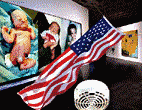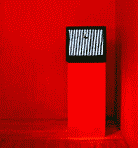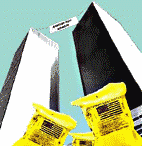|
One
of the most controversial and influential among the traditional American
exhibitions is undoubtedly the Whitney Biennial, which was held this
year for the 71st time at the Washington Whitney Museum of Modern Art.
The exhibition presents the latest of the American artists' paintings,
sculptures, sound and display installations as well as performances,
art films, video and net art. 131 local artists, who took part in the
exhibition, set the tone for new tendencies and trends not only in the
American art scene but also globally.
Both
the exhibition and the works of art presented have come about in the
aftermath of the events of September 11th 2001 in New York and Washington.
The majority of the displays directly or indirectly bear reference to
these tragic events, in which the two twin towers of the World Trade
Center - symbols of the American economic power - were destroyed before
the eyes of the public. These events that have claimed the lives of
civilians, mainly employees of the most powerful multinational corporations,
have spread a sense of insecurity both among the general public and
the ruling establishment, raising the feeling of uncertainty of what
the future brings. All this is reflected in the exhibits that have been
selected by the exhibition curators with surprising tolerance. An attempt
was made to convey the atmosphere of fear and slight panic on the one
hand and the rapidly growing sense of skepticism towards all that is
not American on the other.
The
sculptor Christian Panderewsky's installation, displayed by the
information desk at the entrance hall of the museum, depicts a model
of the WTC towers with a giant boomerang stuck in one of them, bleeding
thick red liquid.This fountain of horror sets the tone for the entire
Biennial exhibition.
Among
the paintings and multimedia installations,displayed on the first floor
level of the museum, the works by Lorna Boyford, Gary Toltek
and Pete Vincerelli deserve particular attention. In a kind of
assemblage, in which she uses various materials and media images, Lorna
Boyford playfully evokes the theme of American history and at the
same time examines the modern social situation, in which the issue of
 colored
members
of the society, i.e. African Americans, still remains a painful one.
Boyford's two meters long display shows a toothless black man
eating a huge sandwich made up of headlines taken from the Washington
Post, New York Times, The Wall Street Journal, Daily News and other
newspapers. colored
members
of the society, i.e. African Americans, still remains a painful one.
Boyford's two meters long display shows a toothless black man
eating a huge sandwich made up of headlines taken from the Washington
Post, New York Times, The Wall Street Journal, Daily News and other
newspapers.
The
painter Gary Toltek reflects on an even earlier period in American
history and the issue of American Indians, the native inhabitants of
America, whose population today has been reduced to a totally insignificant
number from several million at the time of the founding of the United
States. Toltek, renowned for his engaging work, painted a realistic
scene of a Native American man, sleeping in the darkness of a subway,
wrapped in a blanket, and holding a half-empty bottle. Beside his exhausted
face lies a torn Disneyland ticket.
Pete
Vincerelli's work (above, click image to enlarge) looks back
at more recent American History and the Gulf War Syndrome. Vincerelli
points out the effects of inhaling the dust from depleted uranium ammunition
used in Iraq during the Gulf War. A giant panel of illuminated images,
showing children of American war veterans born with deformities, usually
without arms and legs, stretches across five meters of the southern
wall of the exhibition hall. Powered by a Panasonic electric fan, the
American flag is fluttering in front of the panel.
The
second floor of the Whitney Biennial exhibition is dedicated to electronic
media and video installations. The video installations by Margaret
Campbell  and
Ewan Fleuris use the footage of the "jumpers", people
jumping from the highest stores of the WTC. Combining the moving images
with a kind of cosmic sound, Campbell (left, click image to
enlarge) uses slow motion in a symbolic attempt to prolong the life
of those people for a few moments. Fleuris, on the other hand,
includes an animation of suicide bomber planes, which are circling the
towers and threatening new devastation. and
Ewan Fleuris use the footage of the "jumpers", people
jumping from the highest stores of the WTC. Combining the moving images
with a kind of cosmic sound, Campbell (left, click image to
enlarge) uses slow motion in a symbolic attempt to prolong the life
of those people for a few moments. Fleuris, on the other hand,
includes an animation of suicide bomber planes, which are circling the
towers and threatening new devastation.
In
the central part of the exhibition, the sculptor George O. Szobros'
multi-screen installation shows flickering portraits of American homosexuals,
lesbians, drug addicts, representatives of racial and other minorities
as well as uniformed members of various guerrilla fighters from around
the world. A giant plaster cast hand, reaching out from beneath the
portraits, is holding a collection box, which says: "Throw in a
note and you'll get our vote".
Many
other artists taking part in this exhibition also deal with the issue
of social problems and political tensions in modern American society.
Andrew Muller's installation (below left, click image to enlarge), the last one
to be mentioned on this occasion, displays two giant cubes, reminiscent
of the WTC towers. The towers are connected with a piece of string from
which a sign 'American flight schedule' is suspended. At the base of
the two towers yellow food bags lie scattered, similar to those thrown
from planes during the bombing of Afghanistan.
installation (below left, click image to enlarge), the last one
to be mentioned on this occasion, displays two giant cubes, reminiscent
of the WTC towers. The towers are connected with a piece of string from
which a sign 'American flight schedule' is suspended. At the base of
the two towers yellow food bags lie scattered, similar to those thrown
from planes during the bombing of Afghanistan.
With
a range of very powerful exhibits, this year's Whitney Biennial has
truly reflected the age of trauma in which the world is living, using
an often sarcastic and very critical tone as a warning of the possible
consequences.
|

